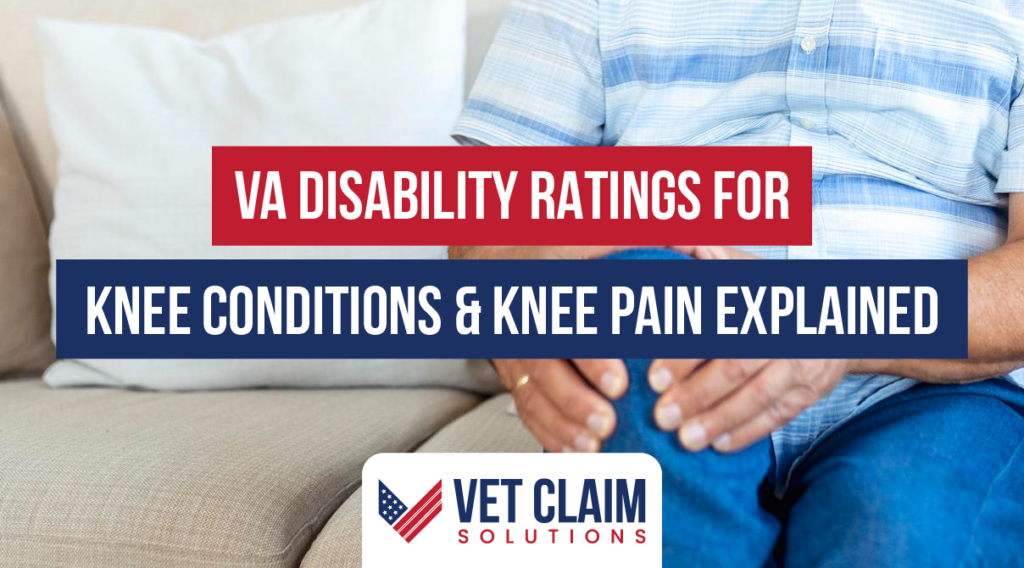
Knee pain can be a debilitating and frustrating condition that affects your mobility, comfort, and quality of life. The Department of Veterans Affairs (VA) recognizes the impact knee problems can have on veterans and offers disability ratings for various knee conditions. This blog post will provide an overview of VA disability ratings for knee conditions and how to get help if you are a veteran suffering from knee pain.
What is Knee Pain in Veterans?
Knee pain in veterans can be caused by a number of different conditions, including arthritis, tendinitis, bursitis, fractures and other injuries. These conditions can cause swelling, stiffness, instability and limited range of motion in the knee joint. In some cases, knee pain may also be related to repetitive movements or trauma from military service.
Why Knee Pain Is Common Among Veterans?
Knee pain is one of the most common complaints among veterans and can be caused by a variety of conditions. Many veterans suffer from knee injuries that were sustained during their active duty service, such as fractures, dislocations, and sprains. In addition, age-related arthritis is also a common cause of knee pain in veterans.
Common Signs and Symptoms of Knee Pain
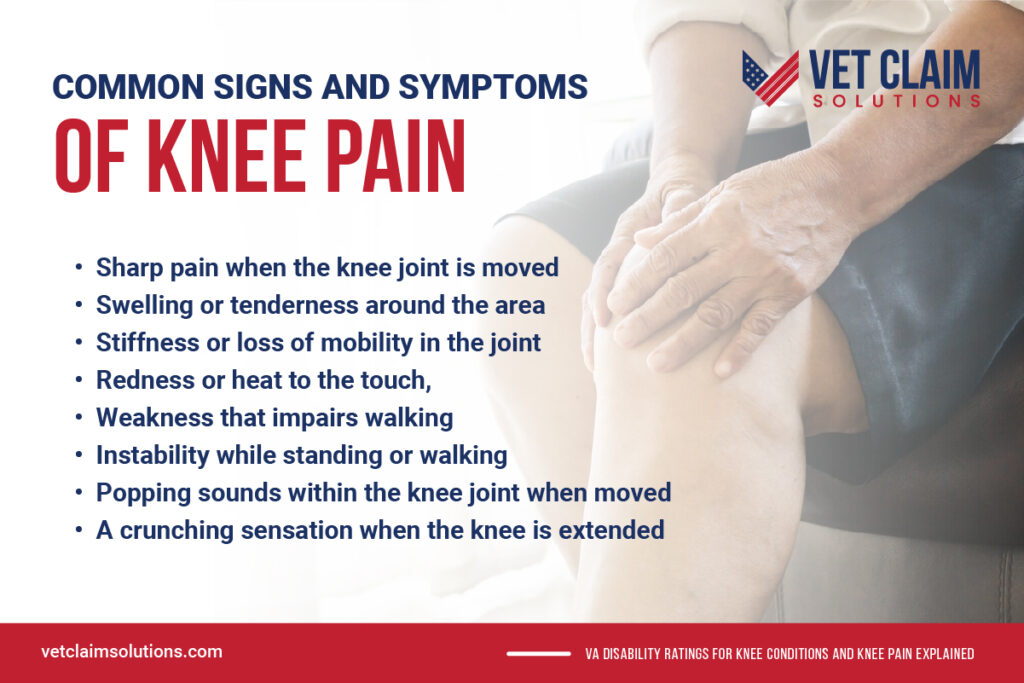
Common signs and symptoms of knee pain in veterans can include
- Sharp pain when the knee joint is moved
- Swelling or tenderness around the area
- Stiffness or loss of mobility in the joint
- Redness or heat to the touch,
- Weakness that impairs walking
- Instability while standing or walking
- Popping sounds within the knee joint when moved
- A crunching sensation when the knee is extended
Knee pain can also cause difficulty fully extending the joint, leading to further complications and mobility issues.
Is Knee Pain a VA Disability?
Knee pain that is caused by a condition or injury related to military service may qualify for VA disability benefits. The Department of Veterans Affairs will assign a disability rating to evaluate the severity of the condition and grant an appropriate level of compensation based on the rating.
Which Knee Conditions Might Qualify a Veteran For VA Disability Benefits?
Which knee injuries or conditions could qualify a veteran for VA Disability benefits? Many veterans may experience knee pain, but it is important to note that this alone may not be enough to qualify them for VA Disability benefits. However, some more serious knee conditions and injuries can mean they are eligible for such benefits. These include:
- Osteomyelitis
- Tuberculosis of the knee
- Rheumatoid arthritis that affects the knees
- Degenerative arthritis
- Gout
- Bursitis
- Knee Instability and Limited range of motion.
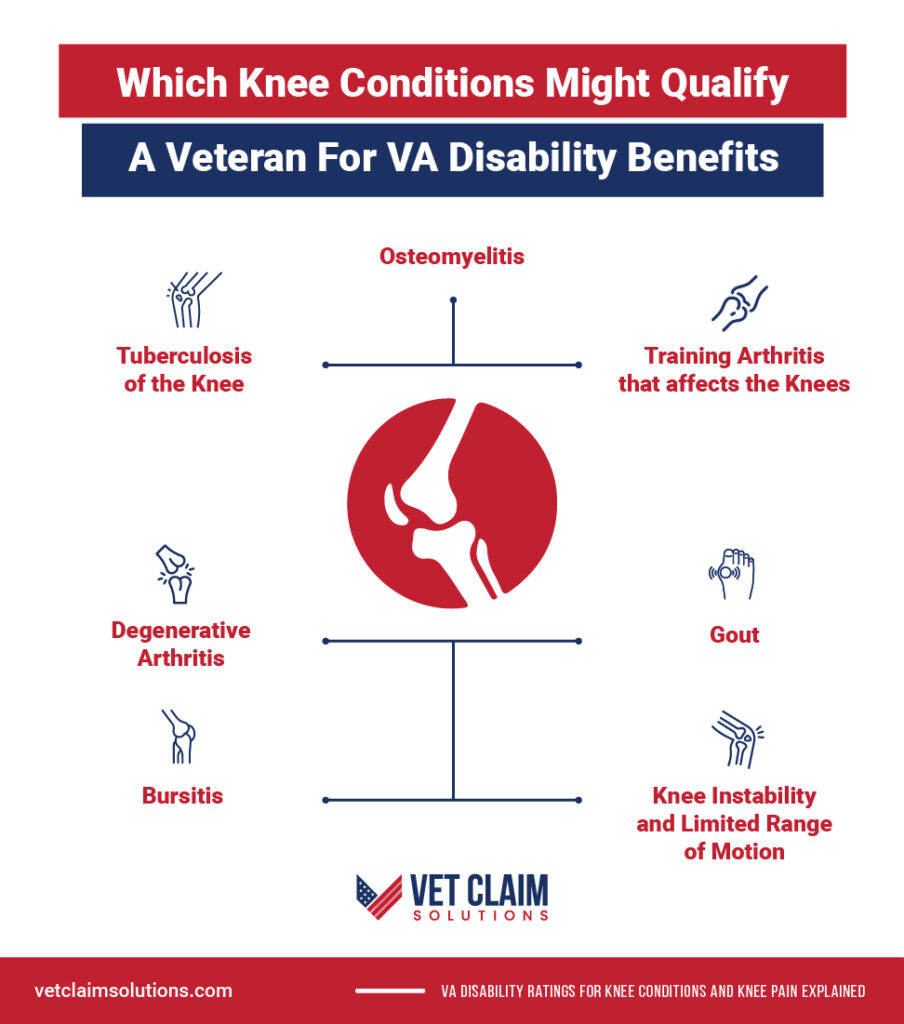
It is important for veterans to seek proper medical care if they experience any kind of knee injury or condition in order to ensure their eligibility for VA Disability benefits.
Common Knee Conditions and How VA Rates Them
Common knee conditions can have a significant impact on a veteran’s quality of life and ability to carry out daily activities. The Veterans Affairs (VA) department takes this into account when assigning disability ratings for these conditions.
Common knee conditions that VA rates include limitation of flexion, limitation of extension, instability, ankylosis, total knee replacements , and partial knee replacements.
Limitation of Flexion
Limitation of flexion of the knee is a condition where the range of motion in the joint is limited when it is bent inward towards the body. VA rates this condition under Diagnostic Code 5260 and based on the range of motion that exists during movement, rather than any pain caused by it. VA assigns a 10 percent rating for limitation of flexion of the knee as standard, but this can go up to a 30 percent rating.
Limitation of Extension
Limitation of extension of the knee refers to when the knee is not frozen but rather is limited in its ability to straighten out. Diagnostic Code 5261 is used for this condition and a 0, 10, 20, 30, 40 and 50 percent disability rating can be assigned depending on the degree of limitation. The higher the limitation in extension, the higher the disability rating.
Instability of the Knee
Knee instability is a condition where the joint can give way when carrying out certain activities. It is rated by VA under Diagnostic Code 5257 and the disability rating is based on the frequency of instability. Generally, a 10 percent rating is assigned for mild instability, a 20 percent rating for frequent instability and a 30 percent rating for continual instability.
Ankylosis of the Knee
Ankylosis of the knee is a condition where movement in the joint is completely restricted due to bone fusion or scar tissue. The VA rates this condition under Diagnostic Code 5256 and assigns a disability rating of 30, 40, 50, 0r 60 percent depending on the range of motion in the joint.
Total Knee Replacements
VA assigns a 100 percent rating for the first year following surgery, after which veterans will be assigned a new rating based on their C&P examination results. If the veteran exhibits weakness and severe pain with motion, then their condition is rated at 60 percent.
If there is not a significant amount of pain, but the range of motion is still limited, VA will rate the total knee replacement under Diagnostic Code 5256, 5261 or 5262 depending on residual symptomology. Regardless of the degree of limitation , the minimum rating for a total knee replacement is 30 percent.
Partial Knee Replacements
Partial knee replacements are a less invasive type of surgery that only replaces the affected portion of the knee joint. VA rates this condition based on any residual symptoms caused by the partial replacement, such as pain or limitation of motion.
How Can You Prove Service Connection for Knee Pain?
To qualify for VA Disability Benefits, veterans must prove that their condition is service-connected. It is important to ensure that the claim includes three essential factors:
- A current diagnosis that directly explains the knee pain,
- Documentation of an in-service occurrence or incident that caused the disability, or at the very least, aggravated the condition, and
- A medical nexus that ties the current disability to something experienced or encountered during active service is needed.
Direct service connection for Knee Pain
When claiming a direct service connection for knee pain, veterans must provide proof of an in-service event or injury that resulted in the current disability or at least aggravated the condition. This includes evidence such as hospitalization records, affidavits from fellow service members who witnessed the incident, medical notes and other records that relate to the knee injury prior to discharge.
Additionally, veterans need to provide copies of their current medical evaluations which detail their current diagnosis and any treatments they have undergone for knee pain. These documents will help to establish that the knee injury was incurred or aggravated during service.
VA Secondary Conditions to Knee Pain
VA secondary conditions to knee pain can be caused by the untreated symptoms of primary knee pain. These secondary conditions include:
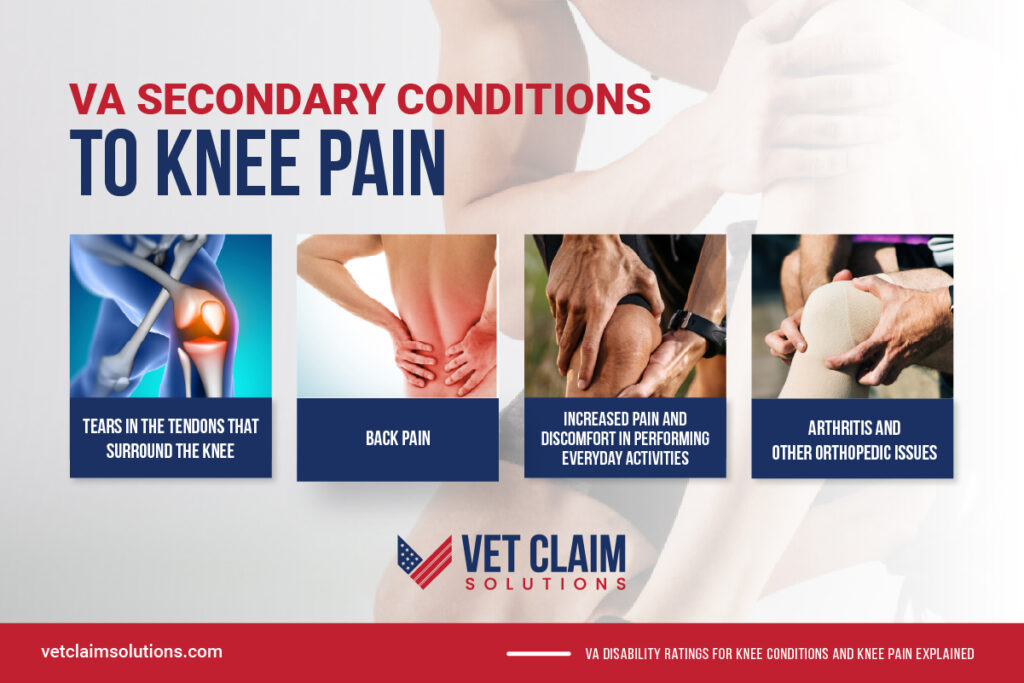
- Tears in the tendons that surround the knee
- Back pain
- Increased pain and discomfort in performing everyday activities
- Arthritis and other orthopedic issues.
Without prompt diagnosis and treatment for knee pain, these secondary conditions can lead to greater disability and reduced quality of life for veterans. It is important to seek medical advice if you are experiencing knee pain or any symptoms associated with it, so that you can be properly examined and treated before secondary conditions develop.
Service Connection by Aggravation
Service Connection by Aggravation is a way to prove disability related to knee pain. A veteran may have had a pre-existing injury that caused knee pain prior to their military service, and the physical demands of service may have made the condition worse.
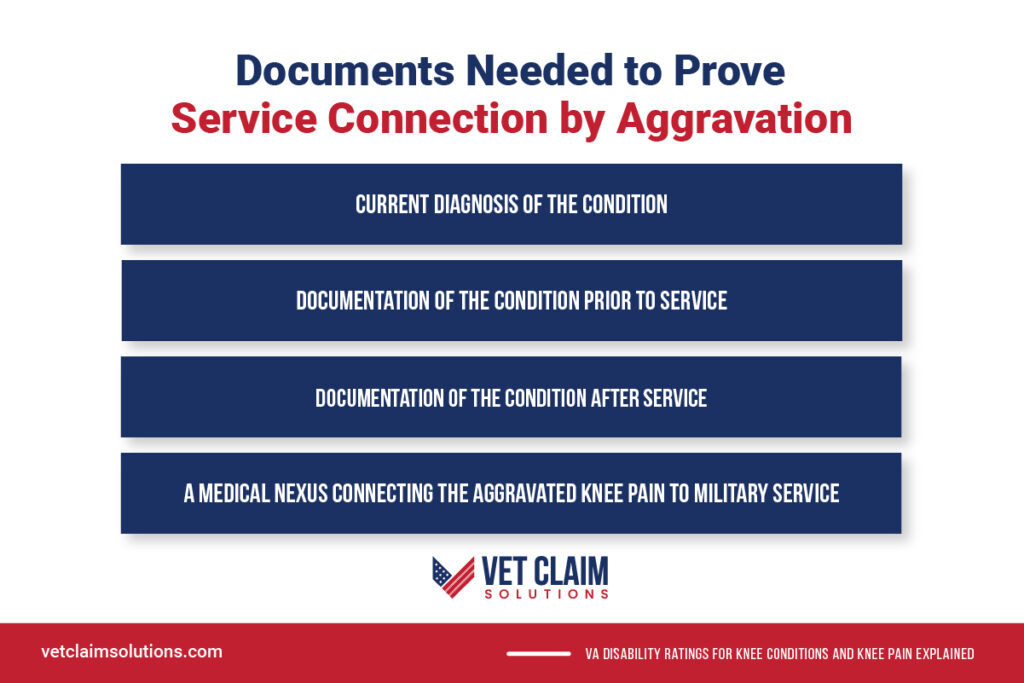
In order to prove this connection, several pieces of evidence are needed including:
- Current diagnosis of the condition
- Documentation of the condition prior to service
- Documentation of the condition after service
- A medical nexus connecting the aggravated knee pain to military service.
This evidence can then be used to support a VA disability claim for conditions relating to knee pain caused or worsened by military service. Additionally, veterans may also be eligible for compensation if their pre-existing knee condition is aggravated by their service-connected disability. For example, if a veteran has a partial joint replacement of one knee they can experience pain in the other knee due to compensation.
Furthermore, evidence such as medical records and statement from a medical professional may be required to prove this secondary service connection.
TDIU for Knee Pain
TDIU can be used to obtain compensation for veterans whose service-connected knee pain makes it impossible for them to work. To apply for TDIU, veterans must provide evidence that their disability is preventing them from working.
Evidence may include a medical opinion that states the veteran’s condition prevents them from working or documentation of an unsuccessful job search. Additionally, veterans may need to explain any other disability-related factors that make it impossible for them to work.
With TDIU, veterans can receive full compensation for their service-connected knee injuries or conditions if they cannot obtain gainful employment due to their disability. This allows veterans with knee pain to obtain the financial support they need while focusing on their recovery.
C&P Exam for Knee Pain
When you submit your application for a veterans disability claim, it is important to provide as much evidence as possible. This may include medical records detailing your pre-existing knee condition and any treatments received since military service.
However, if the VA requires more information, they may ask you to attend a Compensation & Pension (C&P) exam for your knee pain. This exam is conducted by VA medical staff, who will review your file and ask questions based on the medical records you have already provided. They may also do a basic physical exam to observe any changes in your condition.
Additionally, they may request additional tests such as x-rays or blood draws if necessary. It is essential to remember that the doctor who administers your C&P exam is only responsible for evaluating your injury or condition, and not providing any insights about your claim.
After the C&P exam is concluded, the doctor will submit a detailed report to the VA claims processor overseeing your claim. If approved, you may be eligible for full compensation for your service-connected knee condition if you are unable to obtain gainful employment due to your disability.
With the help of TDIU and a C&P exam for your knee pain, veterans can receive the financial support they need while focusing on their recovery.
Need Help Filing a Claim for Knee Pain
If you are a veteran with knee pain caused or worsened by military service, it is important to submit your VA disability claim as soon as possible. The experts at Vet claim solutions can help you build your claim and maximize the compensation you are eligible for. Contact us today to get started on your claim!
We provide comprehensive advice, guidance, and representation during the entire process of filing for veterans disability benefits, from application to appeals. Our team of experienced professionals will work with you every step of the way to ensure that you receive the compensation you deserve. Contact us today to learn more about filing a claim for your knee pain!


